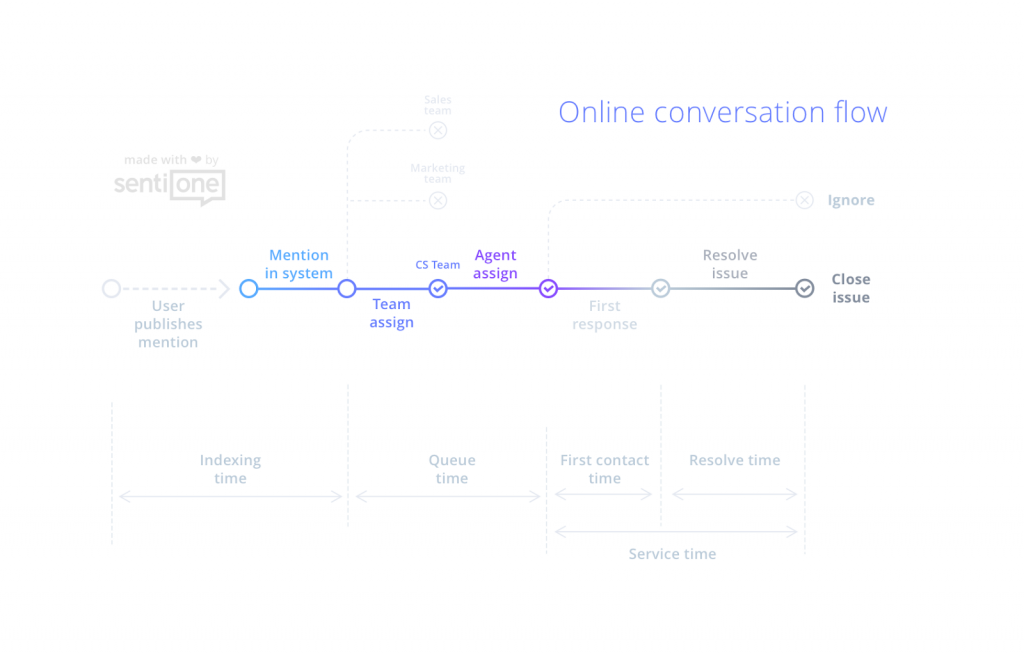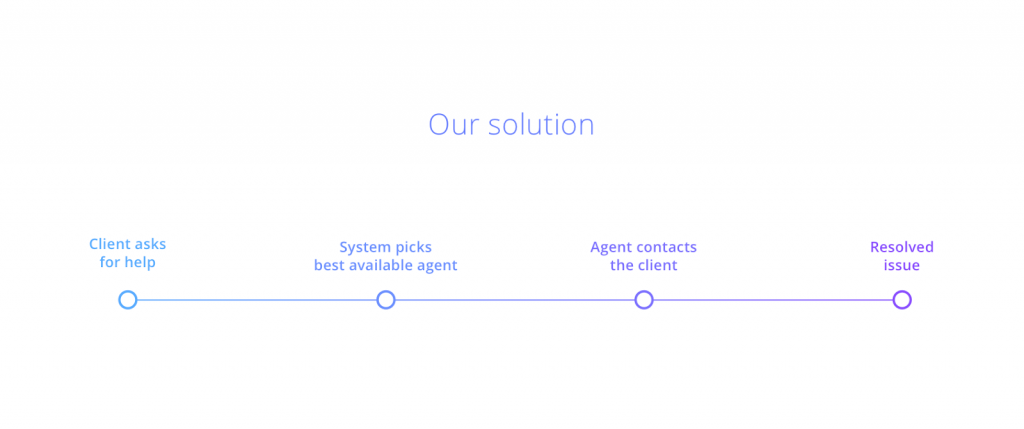How to measure and improve the performance of your Customer Service?
It has been proved that clients reach out to company social accounts more and more often when they have an issue with the product or just a question. That is why, as a company, you better monitor your own channels and react immediately.
Well organised customer service team helps you increase client satisfaction and sales, but to be honest – it is pretty expensive work. This is why proper reporting is required to make sure money is well spent and that your engagement helps you meet your goals.
Proper customer service online reporting can be tricky. Many channels, tools and teams are not making supervisor’s life easier. In this article, I will show you how to track metrics from the first user touch point, to the last one, when agent is closing the conversation for the last time. I will also tell you how to convert those metrics into valuable qualitative reporting so you understand if you’ve met your goals or not. I will also share with you some tips of how you can improve specific metrics across the funnel.
Online conversation flow
As you probably know, online conversations can be public or private. When a user writes a comment under your post on your social channel, everyone can see it. In case this user sends you private messages (on Facebook or Twitter) it is just you and the user who participates in the discussion. Within a public conversation, however, it may happen that your action and service is required more than once because you are mentioned by separate authors.
It is crucial to establish the general flow of the conversation in order to implement proper reporting. It may go like this:
- User publishes mention on a social channel (Facebook, Twitter, Instagram, Portals, Blogs, Forums).
- System that monitors your social channels finds it.
- System assigns this new conversation to the team that is responsible for this medium or particular topic (for example, SentiOne will detect a specified topic based on natural language processing and direct a thread to specified team based on rules set up in the tool).
- System assigns the conversation to the available agent in the team.
- Agent starts to work on the thread – consult it, if required, and create the first response.
- User receives the message and replies, if need be.
- Agent closes the thread when there is no more contact from the user or he resolved the case.
If the user responds after a while, new service is required and the flow repeats.

Metrics that apply to the flow above:
- Indexation delay – metric that will tell you how much delay you have between the original source and the tool that you use for social media management.
- Average queue time – time to take a thread, this metric will tell you how long a conversation is waiting in the queue until an agent is available in the team and can start working on the next ticket. It is calculated from time of assigning to the team until time of assigning to specific user.
- Average reply time – that will tell you how much it takes your agent to create a first response (from assigning to the user to first reply).
- Average service time – this metric will tell you how much it takes your agent to close the thread (from assigning to the agent to closing the thread).
- Average service lifetime that tells you how much time the whole service takes (from indexing the thread in the system to closing it).

What will help you understand the scale of the workload
You have to understand the volume of conversations that your team supports on a daily basis. This article is about reporting but it is worth to mention that those metrics should also be tracked by supervisor in real time, so when a crisis occurs, he is immediately informed and can arrange additional resources to support the team.
Useful metrics for reporting:
- Number of assigned conversations (assigned threads per project)
- Number of finished conversations (closed threads per project)
- Number of assigned conversations per source
- Number of closed conversations per source
- Number of all replies from the system per source
- Response rate (percentage of addressed threads per source) – how many threads were addressed and how many were not. It is the percentage of posts or comments that you respond to.
Top 5 Customer Service KPIs and how to reach them
There are a few common goals for most of the Client Success teams all over the world and a few actions that they usually do in order to reach them. Let me show you which of the KPIs (Key Performance Indicators) are the most popular according to client service experts and why.
Reduce time spent on switching between different channels
How to reach it?
1. Review sources where your engagement is required. Check statistics for specific sources. See the volume of conversations per source and check with your team how long they spend on switching, managing, reporting those separate social channels.
2. If you see a business potential, invest in social media management platform (like SentiOne React) so you have all conversations in on place. Your teams won’t have to switch between portals anymore as you will get all the statements from different sources in one tool. You will be able to set up workflows and processes so your agents won’t have to spend huge amounts of time logging in and out of all the social media platforms.

Reduce time spent on the conversation
How to reach it?
- Review metrics listed above for specific period of time. Check when in the whole flow your team usually faces the biggest challenge. Make sure you understand data and then construct and test hypotheses like:
- If I train my team better, then I will reduce average reply and service time.
- If I provide FAQs materials to the team, then I will reduce average reply and service time.
- If I implement new functionality like AI Answers (suggested replies based on machine learning), then I will reduce average reply and service time.
Decrease time when a user waits for the response
How to reach it?
- Define a process. Who is responsible for what kinds of cases. Set up workflows to send specific conversations the most suitable team. If a thread lands in the proper hands, it will be resolved quickly.
- Review when your audience writes the most often, what days and hour require the most engagement. Allocate responsibilities accordingly. Understand the number of New vs Closed Threads (Average), so you know how many threads have appeared / have been closed in specific time.
- Implement automations like AI Answers that will help your agents construct proper response in no time.
- Implement Messenger ChatBot that will respond on Facebook to conversations automatically. Please, be careful here – it is better to not have any bot than have a bot that doesn’t understand natural language properly and doesn’t make it possible to connect with a real-life consultant when needed. SentiOne makes it possible to integrate Messenger Chatbot with Human Service. If you implement Messenger ChatBot, make sure to track: number of cases resolved by bot, number of cases switched to agent, etc.
Increase customer satisfaction by providing high quality of responses
The more posts, the higher the expectations placed on the Customer Service team. However, it is important not to always respond as soon as possible but rather to respond with the right answer. User should receive an answer that addresses his needs. The supervisor, to make sure that the user receives proper support, reviews conversations and agents’ replies. While choosing a tool, make sure that it allows reviews of closed threads and responses. In SentiOne React, it is possible to add user’s replies to the service report, once you generate it.
How to reach it?
- Prepare communication strategy and train your agents.
- Review conversations from all channels in social media management tool. You can use module like Supervisor Panel in SentiOne React to do it in real time or use Reports functionality to analyse it for the past conversations.
- Don’t allow not-trained agents and newbies to publish mentions on your behalf. Use functions like Approval workflow, so new agents can train by creating drafts, and their responses are reviewed by supervisors each time, until they are ready to go live right away.
Increase Service Level indicator
Service level is a percentage of managed threads against expectations(example: 94% of the threads from Facebook have been served in expected time).
SentiOne React makes it possible to define Service Level KPIs, so you can see within Service Reports module or Supervisor Panel whether your team meets expected goals.
According to your customer service KPIs, you can set up the service level for specific sources (Facebook, Twitter, Instagram, Blogs/forums, other). For example, you can expect that minimum 80% of all threads from all sources will be managed within 24 hours. Information about SL (service level) is available in Service Reports and Supervisor Panel so you can analyse it easily.
When you can expect success and how it is going to affect your business?
If you provide great customer service with excellent service level, you are going to get more positive mentions about your brand soon. Everything needs time and it is important to understand that every change of the process, tools and even people have an impact. And you should measure how every change affects your stats. Remember to run your tests for a while to get statistically valid numbers.
Summary
There are many options to provide better customer service online. However, the key is to learn how to make sure your team provides the best possible customer service. To make good business decisions, you need to start tracking important statistics and spend some time on analysis. You should be able to analyse service for the whole company, different teams, but also for a particular agent. Data-driven decision will help you decide, what should be done in your company to increase online engagement. If you cooperate with external agency, proper reporting will also help you cooperate with them.
We’re here to help because we already have a lot of experience in launching online customer service for big brands. If you wish to see how SentiOne can help you with improving customer service online, don’t hesitate to contact me directly: olga.springer@senti1.com. I’ll be happy to discuss your business needs!



